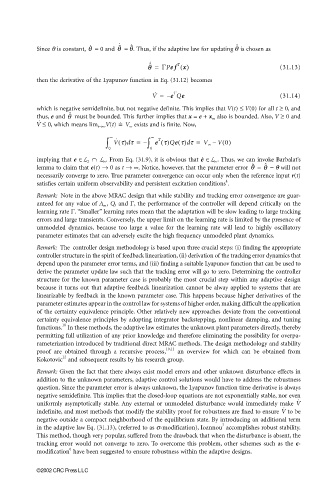Page 945 - The Mechatronics Handbook
P. 945
0066_frame_C31.fm Page 8 Friday, January 18, 2002 5:51 PM
˙
˜ ˙
θ
θ
θ
ˆ
Since θ is constant, = 0 and θ = . Thus, if the adaptive law for updating is chosen as
˙
ˆ
˙
T
θ = ΓPef x() (31.13)
ˆ
then the derivative of the Lyapunov function in Eq. (31.12) becomes
T
˙
V = – e Qe (31.14)
which is negative semidefinite, but not negative definite. This implies that V(t) ≤ V(0) for all t ≥ 0, and
ˆ
θ
thus, e and must be bounded. This further implies that x = e + x m also is bounded. Also, V ≥ 0 and
V ≤ 0 , which means lim t→∞ V(t) V ∞ exists and is finite. Now,
˙
= ˙
∫ ∞ V τ() τd = – ∫ ∞ e τ()Qe τ() τ = V ∞ – V 0()
T
˙
d
0 0
implying that e ∈L 2 ∩ L ∞ . From Eq. (31.9), it is obvious that ∈L ∞ . Thus, we can invoke Barbalat’s
e ˙
lemma to claim that e(t) → 0 as t → ∞. Notice, however, that the parameter error = − θ will notθ θ
˜
ˆ
necessarily converge to zero. True parameter convergence can occur only when the reference input r(t)
4
satisfies certain uniform observability and persistent excitation conditions .
Remark: Note in the above MRAC design that while stability and tracking error convergence are guar-
anteed for any value of A m , Q, and Γ, the performance of the controller will depend critically on the
learning rate Γ. “Smaller” learning rates mean that the adaptation will be slow leading to large tracking
errors and large transients. Conversely, the upper limit on the learning rate is limited by the presence of
unmodeled dynamics, because too large a value for the learning rate will lead to highly oscillatory
parameter estimates that can adversely excite the high frequency unmodeled plant dynamics.
Remark: The controller design methodology is based upon three crucial steps: (i) finding the appropriate
controller structure in the spirit of feedback linearization, (ii) derivation of the tracking error dynamics that
depend upon the parameter error terms, and (iii) finding a suitable Lyapunov function that can be used to
derive the parameter update law such that the tracking error will go to zero. Determining the controller
structure for the known parameter case is probably the most crucial step within any adaptive design
because it turns out that adaptive feedback linearization cannot be alway applied to systems that are
linearizable by feedback in the known parameter case. This happens because higher derivatives of the
parameter estimates appear in the control law for systems of higher order, making difficult the application
of the certainty equivalence principle. Other relatively new approaches deviate from the conventional
certainty equivalence principles by adopting integrator backstepping, nonlinear damping, and tuning
10
functions. In these methods, the adaptive law estimates the unknown plant parameters directly, thereby
permitting full utilization of any prior knowledge and therefore eliminating the possibility for overpa-
rameterization introduced by traditional direct MRAC methods. The design methodology and stability
proof are obtained through a recursive process, 10,11 an overview for which can be obtained from
12
Kokotovic and subsequent results by his research group.
Remark: Given the fact that there always exist model errors and other unknown disturbance effects in
addition to the unknown parameters, adaptive control solutions would have to address the robustness
question. Since the parameter error is always unknown, the Lyapunov function time derivative is always
negative semidefinite. This implies that the closed-loop equations are not exponentially stable, nor even
˙
uniformly asymptotically stable. Any external or unmodeled disturbance would immediately make V
˙
indefinite, and most methods that modify the stability proof for robustness are fixed to ensure to be
V
negative outside a compact neighborhood of the equilibrium state. By introducing an additional term
7
in the adaptive law Eq. (31.13), (referred to as σ-modification), Ioannou accomplishes robust stability.
This method, though very popular, suffered from the drawback that when the disturbance is absent, the
tracking error would not converge to zero. To overcome this problem, other schemes such as the -
6
modification have been suggested to ensure robustness within the adaptive designs.
©2002 CRC Press LLC

